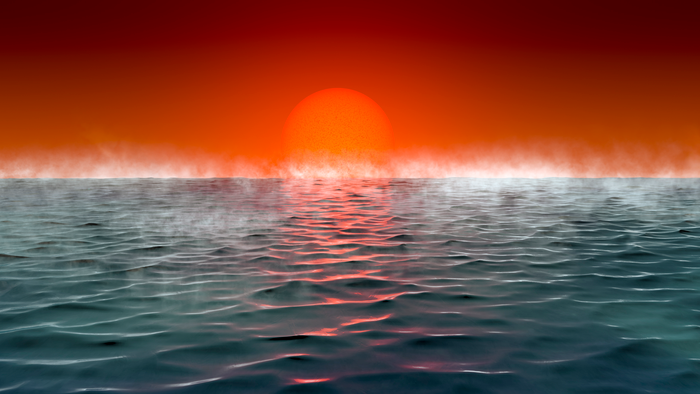Astronomers discover ‘mini-Neptune’ planets that may speed up search for life
Hyceans are hot, ocean-covered planets with hydrogen-rich atmospheres that could support microbial life

Your support helps us to tell the story
From reproductive rights to climate change to Big Tech, The Independent is on the ground when the story is developing. Whether it's investigating the financials of Elon Musk's pro-Trump PAC or producing our latest documentary, 'The A Word', which shines a light on the American women fighting for reproductive rights, we know how important it is to parse out the facts from the messaging.
At such a critical moment in US history, we need reporters on the ground. Your donation allows us to keep sending journalists to speak to both sides of the story.
The Independent is trusted by Americans across the entire political spectrum. And unlike many other quality news outlets, we choose not to lock Americans out of our reporting and analysis with paywalls. We believe quality journalism should be available to everyone, paid for by those who can afford it.
Your support makes all the difference.Astronomers have discovered a new class of habitable ocean-covered “mini-Neptune” planets outside our solar system, an advance that could accelerate the search for alien life forms.
In the quest for finding life outside our Solar System, while scientists have mostly looked for planets of similar size, mass, temperature and atmospheric composition to Earth, astronomers from the University of Cambridge believe the newly discovered habitable “Hycean” planets offer better chances of finding alien life as they are more numerous and observable.
According to the study, published Wednesday in The Astrophysical Journal, the Hycean planets are hot, ocean-covered planets with hydrogen-rich atmospheres, that could increase the chances of finding signs of life outside our Solar System within the next two or three years.
“Hycean planets open a whole new avenue in our search for life elsewhere,” Nikku Madhusudhan from Cambridge’s Institute of Astronomy, who led the research, said in a statement.
These planets, the researchers say, are often referred to as “super-Earths,” or “mini Neptunes,” and are about 2.6 times larger than Earth and have atmospheric temperatures up to nearly 200 degrees Celsius.
While earlier studies noted that the temperature beneath the hydrogen-rich atmospheres of “mini-Neptunes” would be too high to host life, a recent research by Dr Madhusudhan and his team on one such planet – K2-18b – found that in certain conditions these could be habitable.
They say a subset of these are tidally locked “dark” Hycean worlds in which the same side of the planet is in light, and may have habitable conditions on their permanent night sides.
These “Cold Hycean” planets, the astronomers say, receive little radiation from their stars with their oceanic conditions could similar to those conducive for microbial life in Earth’s oceans.
“In this scenario, the only energy source affecting the atmospheric temperature profile is internal heat ... we find that Cold Hycean planets can be readily conducive to ocean life,” the scientists wrote in the study.
“It’s exciting that habitable conditions could exist on planets so different from Earth,” study co-author Anjali Piette, also from Cambridge, said in a statement.
The scientists say such exoplanets are likely quite common, but add that while looking for them, size alone would not be enough to confirm whether a planet is Hycean.
“Other aspects such as mass, temperature and atmospheric properties are required for confirmation,” they added.
Hycean planets, the study noted, lie in the habitable zone, or “Goldilocks zone” of its star.
To determine if they have life, astronomers also look for molecular signs to infer the planet’s atmospheric and internal structure that govern its surface conditions, presence of oceans, and potential for life.
They also need to look for the presence of certain signatures molecules such as oxygen, ozone, methane and nitrous oxide, which are present on Earth, and could indicate the existence of life, as well as markers like methyl chloride and dimethyl sulphide, that may offer hints of life on planets with hydrogen-rich atmospheres.
“Essentially, when we’ve been looking for these various molecular signatures, we have been focusing on planets similar to Earth, which is a reasonable place to start. But we think Hycean planets offer a better chance of finding several trace biosignatures,” Dr Madhusudhan said.
Due to the larger sizes, higher temperatures, and hydrogen-rich atmospheres of Hycean planets the scientists say the atmospheric signatures of these planets are much more detectable than those of Earth-like exoplanets.
The Cambridge researchers say they have identified a sizeable sample of potential Hycean worlds that could be studied with next-generation telescopes like the James Webb Space Telescope (JWST), which is scheduled for launch later in the year.
“A biosignature detection would transform our understanding of life in the universe. We need to be open about where we expect to find life and what form that life could take, as nature continues to surprise us in often unimaginable ways,” Dr Madhusudhan added.
Join our commenting forum
Join thought-provoking conversations, follow other Independent readers and see their replies
Comments